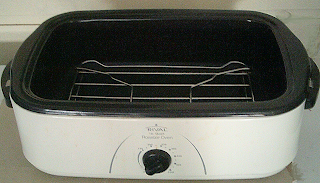Mariner's Cookbook
Olive Loaf: Thoughts, Observations, and Conclusions
The Low Cooking Temperature
The articles I found in my research gave no specific reason for the low (180° F) cooking temperature, but it follows that you can't cook at more common baking temperatures if the food you are cooking is wrapped in lightweight plastic cling wrap. Not to worry though, if you keep the oven at any temperature above 150 °F, the internal temperature of the loaf will eventually get there; at higher temperatures, it just gets there faster, with more browning.
Dealing With Shrinkage
 The Pullman loaf pan I used has a trapezoidal cross-section of 4" (top width) ⨯ 3¾" (bottom width) ⨯ 4" depth. This might appear to be an ideal size and shape for sandwich meat, but it fails to take into account meat shrinkage during cooking.
The Pullman loaf pan I used has a trapezoidal cross-section of 4" (top width) ⨯ 3¾" (bottom width) ⨯ 4" depth. This might appear to be an ideal size and shape for sandwich meat, but it fails to take into account meat shrinkage during cooking.
Granted, there is likely less shrinkage when cooking at 180℉ than when using normal baking temperatures, but at least with the mix of cuts shown in this recipe, shrinkage was significant: possibly as much as a loss of 5% of the volume. This means that cold cuts from this loaf will also be significantly smaller than is ideal. As a result I would recommend using a more conventional loaf pan, accepting the less aesthetically pleasing oblong slices that result.
Another option that might yield more acceptable results would be to stuff the final meat mix into waterproof 4½" sausage casing, seal appropriately, and cook the resulting "chub" in simmering water until the end point temperature of 150° F is achieved.
Cooking
 To do the actual cooking, I used a Rival® model #R0180BR-C roaster oven that we've had for years. It has a couple of significant advantages over the regular oven: first, it allows finer control of the cooking temperature, having a continuous thermostat that operates from 150° F to 450° F, so achieving and maintaining a steady 180℉ is not difficult. Our regular oven can't make this boast. Second, you don't have to heat up the entire house in order to do the cooking. You can even do the cooking outside, provided there is an available outdoor electric outlet; or if it is raining, the oven could be set up in a garage. Since this experiment was conducted in August, this was a huge plus!
To do the actual cooking, I used a Rival® model #R0180BR-C roaster oven that we've had for years. It has a couple of significant advantages over the regular oven: first, it allows finer control of the cooking temperature, having a continuous thermostat that operates from 150° F to 450° F, so achieving and maintaining a steady 180℉ is not difficult. Our regular oven can't make this boast. Second, you don't have to heat up the entire house in order to do the cooking. You can even do the cooking outside, provided there is an available outdoor electric outlet; or if it is raining, the oven could be set up in a garage. Since this experiment was conducted in August, this was a huge plus!
I monitored the internal temperature of the cooking loaf continuously, with a digital probe oven thermometer. The peak internal temperature of the loaf reached 154° F after 4½ hours of cooking at the prescribed oven temperature. One hour after removing the loaf from the oven, the internal temperature only fell to 145 °F.
Ingredients
If you do your own research, you'll find that most recipes specify some amount of salt and sugar. This one doesn't, because we use Morton Tender Quick (TQ) instead. This is because TQ is about 70% common salt and 29% sugar, already, and contains ½% sodium nitrate and ½% sodium nitrite. Most other recipes specify either saltpeter, or Pink Salt (Prague Powder #1) to provide the required nitrates. These ingredients are much higher in nitrates, and thus require less volume of the additive for the preservation function. They also, however, require added salt and sugar to achieve the correct flavor profile. Begin lazy, I'd rather use TQ.
Most recipes for olive loaf also specify white pepper, whereas this one uses black pepper. Black pepper results in a spicier loaf than is usual for deli olive loaf. Others sometimes also include cardamom, coriander, and occasionally allspice. My spice cabinet is full to overflowing with dibs and dabs of different herbs and spices that are only used for one or two dishes. I'm not going to add another, if I don't have to! Besides, I like black pepper in my cold cuts!
Evaluation
If you don't emulsify the meat mix, then don't expect your product to bear more than a superficial resemblance to commercial olive loaf! The texture difference is too great. In fact, given that you don't have a meat processing factory at your disposal, along with all of the chemical "helpers" that the big packers use, you probably shouldn't expect that anyway, but you may find you have a product that you like just as much, or even better.
I chose to skip the emulsification portion of the process, accepting that the final product would have a texture different from that of commercial olive loaf.
Using fattier cuts of meat, or adding pork fat-back (unsalted); and including some quantity of nonfat dry milk, in the meat mix, might moderate the texture issues, as would (perhaps) emulsifying the meat mix. Further experiments may yield more satisfactory results, but in the meantime, I have about six pounds of not-quite-olive loaf to consume before I try again. When I do try again, I will probably use fattier cuts of meat, and may perhaps even eliminate the beef cuts from the recipe.